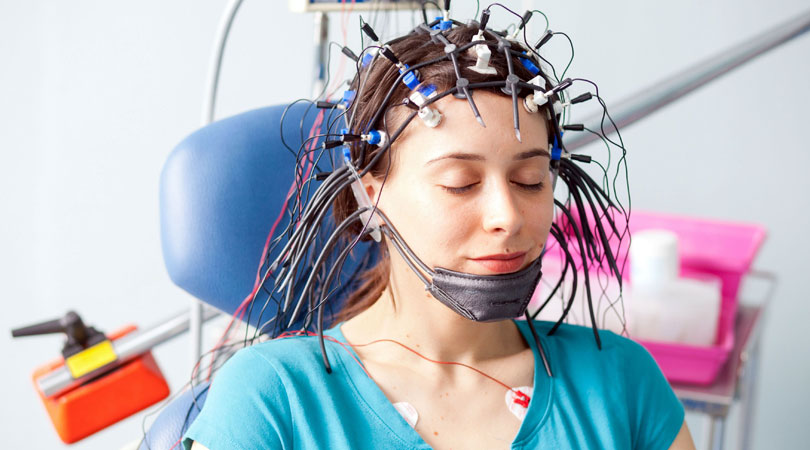
What is an EEG?
An electroencephalogram (EEG) is a test used to evaluate the electrical activity in the brain. Brain cells communicate with each other through electrical impulses. An EEG can be used to help detect potential problems associated with this activity.
An EEG tracks and records brain wave patterns. Small flat metal discs called electrodes are attached to the scalp with wires. The electrodes analyze the electrical impulses in the brain and send signals to a computer that records the results.
The electrical impulses in an EEG recording look like wavy lines with peaks and valleys. These lines allow doctors to quickly assess whether there are abnormal patterns. Any irregularities may be a sign of seizures or other brain disorders.
An EEG is used to detect problems in the electrical activity of the brain that may be associated with certain brain disorders. The measurements given by an EEG are used to confirm or rule out various conditions, including:
- Seizure disorders (such as epilepsy)
- Head injury
- Encephalitis (inflammation of the brain)
- Brain tumor
- Encephalopathy (disease that causes brain dysfunction)
- Memory problems
- Sleep disorders
- Stroke
- Dementia
When someone is in a Coma, an EEG may be performed to determine the level of brain activity. The test can also be used to monitor activity during Brain surgery.
There are no risks associated with an EEG. The test is painless and safe.
Some EEGs do not include lights or other stimuli. If an EEG does not produce any abnormalities, stimuli such as strobe lights, or rapid breathing may be added to help induce any abnormalities.
When someone has epilepsy or another seizure disorder, the stimuli presented during the test (such as a flashing light) may cause a seizure. The technician performing the EEG is trained to safely manage any situation that might occur.
Before the test, you should take the following steps:
- Wash your hair the night before the EEG, and don’t put any products (like sprays or gels) in your hair on the day of the test.
- Ask your doctor if you should stop taking any medications before the test. You should also make a list of your medications and give it to the technician performing the EEG.
- Avoid eating or drinking anything containing caffeine for at least eight hours before the test.
- Your doctor may ask you to sleep as little as possible the night before the test if you have to sleep during the EEG. You may also be given a sedative to help you relax and sleep before the test begins.
- After the EEG is over, you can continue with your regular routine. However, if you were given a sedative, the medication will remain in your system for a little while. This means that you’ll have to bring someone with you so they can take you home after the test. You’ll need to rest and avoid driving until the medication wears off.
An EEG measures the electrical impulses in your brain by using several electrodes that are attached to your scalp. An electrode is a conductor through which an electric current enters or leaves. The electrodes transfer information from your brain to a machine that measures and records the data.
Specialized technicians administer EEGs at hospitals, doctor’s offices, and laboratories. The test usually takes 30 to 60 minutes to complete, and involves the following steps:
- You’ll lie down on your back in a reclining chair or on a bed.
- The technician will measure your head and mark where to place the electrodes. These spots are scrubbed with a special cream that helps the electrodes get a high-quality reading.
- The technician will put a sticky gel adhesive on 16 to 25 electrodes, and attach them to spots on your scalp.
- Once the test begins, the electrodes send electrical impulse data from your brain to the recording machine. This machine converts the electrical impulses into visual patterns that appear on a screen. A computer saves these patterns.
- The technician may instruct you to do certain things while the test is in progress. They may ask you to lie still, close your eyes, breathe deeply, or look at stimuli (such as a flashing light or a picture).
- After the test is complete, the technician will remove the electrodes from your scalp.
- During the test, very little electricity passes between the electrodes and your skin, so you’ll feel very little to no discomfort.
- In some instances, a person may undergo a 24-hour EEG. These EEGs use video to capture seizure activity. The EEG may show abnormalities even if the seizure does not occur during the test. However, it does not always show past abnormalities related to seizure.
A neurologist (someone who specializes in nervous system disorders) interprets the recordings from the EEG and then sends the results to your doctor. Your doctor may schedule an appointment to go over the test results with you.
Normal results
Electrical activity in the brain appears in an EEG as a pattern of waves. Different levels of consciousness, like sleeping and waking, have a specific range of frequencies of waves per second that are considered normal. For example, the wave patterns move faster when you’re awake than when you’re asleep. The EEG will show if the frequency of waves or patterns are normal. Normal activity typically means you don’t have a brain disorder.
Abnormal results
Abnormal EEG results may be due to:
- Epilepsy or another seizure disorder
- Abnormal bleeding or hemorrhage
- Sleep disorder
- Encephalitis (swelling of the brain)
- Tumor
- Dead tissue due to a blockage of blood flow
- Migraines
- Alcohol or drug abuse
- Head injury
It’s very important to discuss your test results with your doctor. Before you review the results, it may be helpful to write down any questions you might want to ask. Be sure to speak up if there’s anything about your results that you don’t understand.



